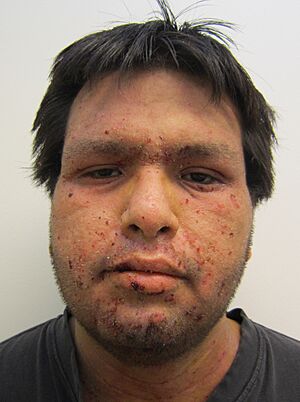Impetigo facts for kids
Impetigo is a very catchy skin infection caused by tiny germs called bacteria. It's most often seen in younger kids. Teens and adults who play sports where they touch each other a lot, like rugby or American football, can also get it. It's not as common in grown-ups. Sometimes people call impetigo school sores.
Contents
What is Impetigo?
Impetigo is a common skin infection. It makes red sores or blisters appear on the skin. These sores can break open and form a yellowish-brown crust. It's important to know that impetigo is very easy to spread from one person to another.
How do you get Impetigo?
Impetigo is caused by two types of bacteria: Staphylococcus aureus or Streptococcus pyogenes. These bacteria can get into your skin through small cuts, scrapes, or even insect bites. Once the bacteria are in, they can cause the infection. You can also get impetigo by touching someone who has it. Sharing towels, clothes, or toys with an infected person can also spread the bacteria.
What does Impetigo look like?
Impetigo usually starts as small red spots or blisters. These often appear around the nose and mouth. They can also show up on the arms, legs, or other parts of the body. The blisters might be filled with a clear or yellowish fluid. When the blisters pop, they leave behind a sticky, honey-colored crust. The skin under the crust can be red and itchy. It's important not to scratch the sores, as this can spread the infection.
How is Impetigo treated?
If you think you have impetigo, it's important to see a doctor. A doctor can usually tell if it's impetigo just by looking at your skin. They will often prescribe an antibiotic cream or ointment. You put this cream directly on the sores. For more serious cases, or if the infection has spread, the doctor might give you antibiotic medicine to take by mouth. It's very important to use all the medicine as prescribed, even if the sores start to look better. This helps make sure all the bacteria are gone.
How can you prevent Impetigo?
Preventing impetigo is mostly about good hygiene. Here are some tips:
- Wash your hands often with soap and water.
- Keep cuts, scrapes, and insect bites clean. Cover them with a bandage.
- Avoid sharing personal items like towels, clothes, and razors.
- If someone in your home has impetigo, make sure they use their own towel and washcloth.
- Wash bedding and clothes of an infected person in hot water.
By following these steps, you can help stop the spread of impetigo.
See also
 In Spanish: Impétigo para niños
In Spanish: Impétigo para niños


